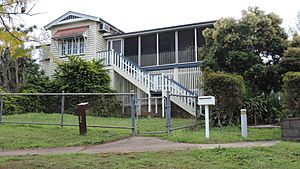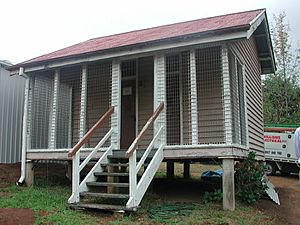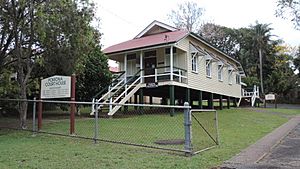Pomona Police Station and Court House facts for kids
Quick facts for kids Pomona Police Station and Court House |
|
|---|---|

Former Pomona Police Station (now police residence), 2015
|
|
| Location | Red Street, Pomona, Shire of Noosa, Queensland, Australia |
| Design period | 1919 - 1930s (interwar period) |
| Built | 1934 |
| Official name: Pomona Police residence (& former station), lock-up and courthouse | |
| Type | state heritage (built) |
| Designated | 27 May 2005 |
| Reference no. | 602515 |
| Significant period | 1930s (historical) 1930s (fabric) |
| Significant components | police station, toilet block/earth closet/water closet, residential accommodation - police sergeant's house/quarters, lock-up, court house |
| Lua error in Module:Location_map at line 420: attempt to index field 'wikibase' (a nil value). | |
The Pomona Police Station and Court House is a special group of old buildings in Pomona, Queensland. They are listed on the Queensland Heritage Register because they are important to history. Built in 1934, these buildings include a police residence (which used to be the police station), a court house, and a lock-up (a small jail). They show how law and order worked in Queensland a long time ago.
Contents
Pomona's Early Days
The area around Pomona was first used for cattle farms in the 1850s. Later, in the 1860s, people started cutting down trees for timber. Laws like the Crown Land Alienation Acts helped people get cheap land. This led to more people moving in and harvesting valuable trees like kauri and cedar.
Gold and Railways
The discovery of gold in Gympie in 1867 also helped the area grow. Railways were built to move timber and goods. The Gympie-Cooran rail link opened in 1889. The line from Eumundi to Cooroy was built in 1891.
How Pomona Got Its Name
Pomona was created to give settlers better access to the North Coast railway line. Before 1900, the train stop was called "Pinbarren siding." Since "Pinbarren" was already used for another town, the new town was named Pomona. This name comes from the Roman Goddess of fruit. The local school became Pomona State School in 1908. The Noosa Shire was formed in 1909, with its main office in Pomona until 1980.
From Timber to Dairy Farms
In the early 1900s, the main industry changed from timber to dairy farming. Farmers from New South Wales moved here to raise dairy cows. People also grew fruit, sugar cane, and maize. Butter factories were built in nearby towns like Kin Kin (1912) and Cooroy (1915). Pomona also got its own butter factory in 1919.
Bananas and Beef
Bananas were also a big crop in the 1920s. But a disease called "Bunchy Top" ruined many banana farms in the 1930s. After that, dairy farming was the main industry until the 1960s. Then, beef cattle farming became more popular. By the 1990s, Pomona focused on fruit and making furniture.
Policing in Queensland
The way police worked in Queensland changed over time. In 1863, the police system became more organized under a Police Commissioner. Ranks like Inspector and Sergeant were introduced. The Police Department was part of the Home Secretary's office for many years. In 1970, a separate Police Department was created.
Pomona Needs a Police Station
People in Pomona started asking for a police station as early as 1910. The manager of the local bank wrote to the government. He said the nearest police officer was far away in Tewantin. Pomona had two banks with a lot of money, so they needed protection. A local Justice of the Peace also agreed that Pomona needed police.
At first, the police only visited Pomona a few times a week. The Police Commissioner at the time, William G. Cahill, did not agree to send an officer to Pomona permanently.
Pomona Keeps Trying
But Pomona residents did not give up. In June 1910, a group from Pomona went to Brisbane to talk to the Home Secretary, John Appel. They explained why Pomona needed a police station. An inspector named P. Short reported that Pomona was a growing area with many new settlers. He also noted that "undesirables" (people who might cause trouble) were passing through. Pomona had banks, shops, a hotel, a school, and a newspaper, showing it was an important town.
A Temporary Solution
Even though nearby towns like Cooran and Cooroy got police stations by 1920, Pomona still did not have one. In 1926, an inspector recommended a station for Pomona. In 1927, a local man named Mr. Blanckensee offered to build a house for the police to rent. He would build a four-room house with a kitchen and verandas. He also offered to build a stable for horses.
The police accepted this offer. On 3 November 1927, the Pomona Police Station officially opened. Constable Harry England Brown was the first officer stationed there.
A Court House for Pomona
Around the same time, officials visited Pomona to decide where to hold court sessions. Local business people said Pomona was a good central spot. In December 1927, Pomona was chosen to hold "Courts of Petty Sessions" (local court hearings). This meant the police station needed a cell. A small, removable lock-up (jail cell) and an outdoor toilet were built on Blanckensee's property in 1928.
For court sessions, Constable Brown used an office at the Pomona School of Arts building. He could also use the main hall for court cases. But this arrangement was not ideal. Constable Brown often complained that he lacked privacy and was interrupted by community groups using the hall.
A New Station and Court House
In 1930, the Police Commissioner agreed that Pomona needed a new, proper police station and court house. Pomona was a central town for many police divisions and held court sessions. However, the lease on Blanckensee's house was renewed instead.
Constable Brown tried again in 1932. He argued that a new police station, court house, and a second cell were needed. He pointed out that the old lock-up could be moved and reused.
Finally, in April 1933, suitable land was found for the new buildings. On 13 June 1934, construction began on a new police station (which also served as the officer's home), a two-cell lock-up, a court house, and a stable. The work was finished by 31 August 1934. The new police station cost about £1030, and the court house cost about £524.
The Design of the Buildings
The police station was designed by Harold James Parr from the Department of Public Works. It was a "Type Two" station, meaning it was a standard design used in many places. It was built high off the ground with wooden walls. It had an office, three bedrooms, a living room, and a kitchen. It also had verandas and water tanks. In those days, police stations often combined an office and a home, especially in country areas.
Changes Over Time
Over the years, only small changes were made to the buildings. In 1940, a police officer asked to park his car under the house. In the 1950s, officers asked for painting, mosquito proofing, and repairs. In 1956, the stable was changed to store a motorcycle.
Later, in the 1960s, officers asked for a septic system (modern plumbing). They also asked for parts of the verandas to be enclosed to keep out rain.
Pomona was a two-officer station for some years. But in 1963, a report suggested it could go back to being a one-officer station. This was because the new Bruce Highway bypassed Pomona, making it less busy.
The court house moved to Noosa Heads in 1987. The lock-up stopped being used as a jail around that time. Today, the court house is still used a few days a week for civil matters like small claims. The old lock-up is now used for police storage.
In 2004, a new, modern police station was built between the old station and the court house.
What the Buildings Look Like
The Pomona Police and Court House area has ten buildings today. The court house faces Red Street. The old police residence (which was the station) is also on Red Street. The new police station is built between them. The old lock-up is behind the 1934 police residence.
The Lock-up
The lock-up is a low, wooden building with two cells. It has a metal roof and stands on concrete stumps. The cells have strong steel doors and barred windows. The inside walls are made of unpainted wooden boards. This building might even be older than 1934 and could have been moved here.
The Court House
The court house is a tall, wooden building. It stands on concrete posts. It has window covers made of corrugated steel over glass louvre windows. The roof has vents at the ends. There is a wooden ramp leading to an office at the back. It also has a front veranda. Inside, the courtroom still has the original wooden judge's bench, witness stand, and prisoner's dock.
The Police Residence
The 1934 police residence is also a tall, wooden building. It has the same window covers and windows as the court house. Its L-shaped veranda has been enclosed. The front of the house has a gable (a triangular part of the wall under the roof) with the office. Stairs lead up to this office. The back of the house has another gable with the kitchen. The original design had three bedrooms and a living room. Outside, it looks very much like the original plans, except for the enclosed verandas and the missing water tanks.
Other Buildings
There is an old outdoor toilet (Earth Closet) east of the lock-up. There is also a wooden shed that faces Rectory Street. This shed might be the old stable that was changed to store a motorcycle. It has a single-sloped roof and a new roller door.
Around the property, you can see two large palm trees and a bottle tree. There is also a metal fence. The new concrete police station, the new concrete toilets, an old chicken pen, a new aluminum shed, and a small garage are not considered historically important.
Why It's Heritage Listed
The Pomona Police residence (and former station), lock-up, and court house were added to the Queensland Heritage Register on 27 May 2005. This means they are protected because they are important for several reasons:
Shows History
These buildings show how Queensland's history has changed, especially in Pomona and the Noosa Shire. They also show how police and justice services have developed over time. They are good examples of standard building designs used by the Department of Public Works to build important government buildings in growing towns.
Shows Building Style
This group of three government buildings, all built in the same year on the same site, is a great example of a small town police station and court house. They show the typical design and work of the Department of Public Works.
Looks Good
As a well-preserved group of 1930s police and court buildings, the site reminds us of how law enforcement worked in a small country town long ago. Even though they were built simply, they are good examples of how buildings were designed to suit Queensland's warm climate. The inside of the court house, especially the courtroom, still has its original furniture.
Important to the Community
These buildings have a strong and ongoing connection with the local community. The people of Pomona worked hard to get a police station. The precinct has always provided important law and justice services to the area, and it continues to do so.




